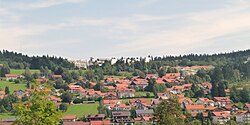This article needs additional citations for verification. (August 2016) |
Sankt Englmar (English: Saint Englmar) is a municipality in the district of Straubing-Bogen in Bavaria, Germany.
Sankt Englmar | |
|---|---|
 Sankt Englmar | |
Location of Sankt Englmar within Straubing-Bogen district  | |
| Coordinates: 49°0′N 12°49′E / 49.000°N 12.817°E | |
| Country | Germany |
| State | Bavaria |
| Admin. region | Niederbayern |
| District | Straubing-Bogen |
| Government | |
| • Mayor (2020–26) | Anton Piermeier[1] (CSU) |
| Area | |
| • Total | 36.85 km2 (14.23 sq mi) |
| Elevation | 808 m (2,651 ft) |
| Population (2022-12-31)[2] | |
| • Total | 1,927 |
| • Density | 52/km2 (140/sq mi) |
| Time zone | UTC+01:00 (CET) |
| • Summer (DST) | UTC+02:00 (CEST) |
| Postal codes | 94379 |
| Dialling codes | 09965 |
| Vehicle registration | SR |
| Website | gemeinde |
History edit
A hermit named Engelmarus, who was born in 1060 in Lüftlhof, Passau. He was a hermit, very popular and highly esteemed, who lived in the 11th century in a wood near Passau, Passau in Italian, the enchanting Bavarian city stretched out like the bow of a ship on the V-shaped confluence of the Inn in Danube; just at the point where the two large and solemn rivers that bathe the two sides of the town meet, a third river, the Ilz, flows into those waters, helping to make the place truly suggestive. Passau - in whose Gothic cathedral there is one of the largest organs in the world, full of 17,000 pipes that every Sunday morning make the majesty and charm of their sound heard in a public concert - was the episcopal see since 739, and to the left of the Danube, on an outcrop dominating the city, the Oberhaus fortress (18th century), residence of the bishops, still stands. Engelmaro was born in Bavaria to a poor peasant family. Prone to pity and solitary life, he could have as a master of the spirit a pious Armenian hermit, named Gregory, ex-bishop eager for solitude and perfection, who had retired to the Bavarian forest to prepare for death. After Gregorio died in 1093, Engelmaro remained alone in that hermitage, near the small center of Windberg, leading a life of work, austerity and prayer. The inhabitants of the region continued to visit him, to ask for advice and comfort, as they did when the bishop was still alive. Soon the hermit saint was surrounded by the esteem and affection of all; but the great veneration of which he became the object and his own virtues aroused the envy of a man who for some time had subtly associated with him, making believe that he wanted to lead under his guidance that hard existence, and that on the night between 13 and 14 January 1100 killed him barbarously, hiding his body under the snow and immediately leaving the country. According to another tradition, that wretch killed Engelmaro to take possession of the treasures he supposed he had: but he found nothing, since the good hermit distributed all the offerings he received to the poor. The fact is that that horrible action was discovered only a few months later, when the snow and the remains of the hermit melted, they reappeared and were noticed by a priest, who arranged to bury them. Legend has it that a beam of light radiated from the dead man's body. In 1331 the Premonstratensians of Windberg transported the remains of Engelmaro to their church, where the saint's tomb is still a pilgrimage destination. Every year the inhabitants of the village of Saint-Englmar still practice an ancient custom, called "In search of Engelmaro", pretending to go in search of the body of the saint hidden by the murderer: an image of the saint is hidden in the woods once found, it is brought back to town with a solemn procession. Sankt Englmar is named for him.[3] Saint Engelmaro is a patron saint of good weather.[4]
References edit
- ^ Liste der ersten Bürgermeister/Oberbürgermeister in kreisangehörigen Gemeinden, Bayerisches Landesamt für Statistik, 15 July 2021.
- ^ Genesis Online-Datenbank des Bayerischen Landesamtes für Statistik Tabelle 12411-003r Fortschreibung des Bevölkerungsstandes: Gemeinden, Stichtag (Einwohnerzahlen auf Grundlage des Zensus 2011) (Hilfe dazu).
- ^ http://www.santiebeati.it/dettaglio/92120
- ^ St. Engelmaro


